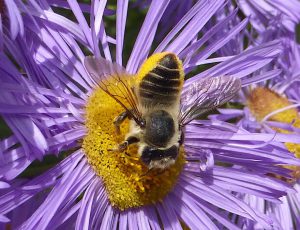Bug Bytes: Leafcutter Bees
Leafcutter bee pollinating a flower.
Glenn Marangelo
Have you ever noticed a leaf that looks like someone attacked it with a hole punch?
You, my friend, are in the presence of one of the world’s most efficient pollinators: leafcutter bees.
Instead of collecting pollen in “baskets” located on their hind legs like honey bees and bumblebees, leafcutters are a unique family of bees that really dive into their work. For collection, they have a dense mass of branched hairs on the underside of their abdomen, called a scopa.
Leafcutters look like they’re belly-surfing a flower. With an energetic, swimming-like motion, they release large amounts of pollen, packing their scopa and giving them a yellow, golden-colored belly.
But the pollen falls off easily as they move, making them efficient pollinators, but inefficient foragers. This requires leafcutters to make more foraging trips than other bees — the reason why they are such important pollinators.
Female leafcutters make a tube-like nest of individual cells for each egg they lay, using a natural or artificial cavity like a hollow plant stem or the many tubes of a bee hotel. Each cell is constructed with pieces of leaves or flower petals.
But not just any leaf will do. Leafcutters are picky, looking for leaves with just the right texture and thickness. Once a prime leaf is found, she’ll cut a near-circular piece with her jaws, curl the piece in half, and fly back to her nesting site.
So, while you may not visually appreciate the holes in your leaves, the beneficial impacts leafcutters have in pollinating alfalfa, blueberries, squash, melons and other summer vegetables and fruits is certainly worth the tradeoff.
Bug Bytes: Leafcutter Bees | Montana Public Radio (mtpr.org)









